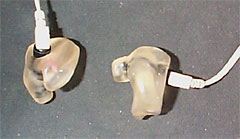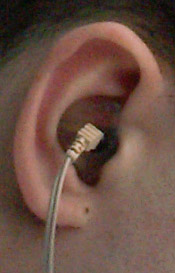![[SoundStage!]](../sslogo3.gif) Fringe with Greg Smith Fringe with Greg SmithBack Issue Article |
| August 2000 Custom Ear Molds for the Etymotic ER-4S Headphones The Jacob K. Javits Convention Center in Manhattan is rarely a quiet place. When the Audio Engineering Society holds their convention there every two years, the racket of demo music ("you will not believe how loud our studio monitors will play!") adds to the noise of the big crowd, making for a show that leaves your hearing rather beat by the end of the day. When the guy from Precision Laboratories poured the green goop into my ears, I had the somewhat surreal experience of being in the middle of that flurry of activity, but not hearing any of it. I've had this dysfunctional relationship with the
Etymotic Research ER-4S headphones for over two years now. I love the way they sound and
their portability, but I hate the way they feel inside my ears. While reading through the
AES booklet, I discovered that one of the companies at the show made custom ear molds
specifically for that model, so I stopped by the booth expecting to get some more
information on the process. I got an earful in more ways than one. Come to find, they had
brought all the equipment along to cast an impression of my ear canal right on the spot. About two weeks later, UPS dropped off my completed ER-4S ear pieces. Precision drills a hole just the right size to hold the Etymotic headphones in. And I mean just the right size; the fit is so tight that it will take you a set of pliers to get the headphones back out again. This is the main down side of the custom-mold upgrade; once it's done, you are not going to casually put the old, stock end pieces back again. It's a substantial amount of work to install and remove the custom molds, and letting other people borrow your Etymotics becomes quite the chore. The comfort problems with the ER-4S are in two categories. There is the odd feeling that you've got something in your ear; apparently some people never get used to this, while I find that once I get lost in the music I stop noticing. For me the far great irritation is that either of the regular ear pieces made the inside of my ear itch after half an hour or so of listening. Obviously, getting a custom mold made still involves putting something in your ear, so that concern doesn't go away. But the smooth plastic of the Precision mold is otherwise easy to live with. The hearing-aid applications require an appliance that can be comfortably left in all day, so the company has a lot of practice satisfying people who use their molded pieces for far longer than a headphone listener is likely to. Even if that were the only benefit, a custom-fitted mold might be justifiable. But the bonus is that the headphones can sound better too. Most noticeably, bass response of the ER-4S is very influenced by how tight of a seal you get when you put the plugs in. While the stock earplugs can be made to work well in most ears, in my case the custom molds were dramatically better at staying tight. This has two major benefits. A tighter seal means more isolation from the outside world, and it also translates into more powerful deep-bass response. The second sonic benefit is a smoothing out of the high frequencies, removing a bit of glare. This is certainly welcome when using the Etymotics with a portable CD player, which as a group tend to inject some harshness of their own. And once you've got the impressions made, you can also have custom-made hearing protection as well. Etymotic has a line of earplugs with a frequency response tailored for music listening that are popular among musicians. I plan to order a set of these at some point from Precision. This was supposed to be the end of my story, but then I made the mistake of making a phone call that complicated things considerably. There are apparently three companies making significant volumes of ER-4S molds. Precison Labs is the one I ordered from. If you call up Etymotic, the first name that they mention is Ear Mold Design. And finally, there's Westone, the company that HeadRoom recommends based on some work they did together. Starting with the ear mold cast out of silicone, you have to bore a hole in order to have a place to insert the ER-4S. That cavity will typically taper down as it gets closer to your ear, kind of like an inverted horn. And just like a horn, you can adjust the way the headphone sounds by adjusting the shape of this hole. As part of some research with Westone into what makes the best type of ear mold for getting a high-end-audio kind of sound, Tyll Hertsens settled on a shape similar to an exponential curve. Westone's Carl Cartwright states that this gives a brighter output above 2kHz than a more traditional taper. If your molds are being made by Westone, you can pass along a request for the "HeadRoom Bore" if you'd like to try this alternative. Carl also suggests that the decrease in glare I noted above is primarily due to the fact that the silicone the custom molds are made from is softer than the plastic of either stock Etymotic tube. Since the sound is bouncing off each design, a softer material has a similar effect to adding curtains or some other absorbent material to a home listening room.
After a few months, no complaints so far about my molds except that they're starting to get a bit grungy. In order to clean the silicone, you should remove the headphones first, as you certainly don't want water in them. An alcohol-based cleaner might eat away at the mold, so some water with a bit of regular soap is sufficient. A couple of companies sell sprays and accessories for taking care of molds like these. Audex has the nicer catalog but aims mainly at sales through audiologists, while ADCO has an online shopping system you can order through. Even with good care, it's worth noting that an ER-4S mold is likely to last around five years before it wears enough that it may need replacement. Also, if your weight changes substantially, by at least 20 pounds, your ear can change size enough that you'll need a new fitting. This is certainly the case if you've gained or lost 40 or more pounds. Portable-headphone listening keeps moving up in quality. In addition to this upgrade, Headroom recently announced reduced prices and a better model of the AirHead amplifier I'm planning to try (even if it's not listed on the website yet). I'm looking forward to a few years of better listening with these custom ear molds, along with even more funny looks from people as I ride the trains around here. ...Greg Smith
|
|
![[SoundStage!]](../sslogo3.gif) All Contents All ContentsCopyright © 2000 SoundStage! All Rights Reserved |
 First a small plastic piece is inserted to keep the fluid from going
into your inner ear. Then the aforementioned goop is poured in. It takes a few minutes to
set, after which the whole shebang is pulled out. When I asked him about this whole
process a while back,
First a small plastic piece is inserted to keep the fluid from going
into your inner ear. Then the aforementioned goop is poured in. It takes a few minutes to
set, after which the whole shebang is pulled out. When I asked him about this whole
process a while back,  While it's
certainly nice that there are so many options available, I don't think that concentrating
on the molding company is necessarily the best way to approach getting a custom mold like
this. All three companies are using the same kind of materials and procedures. You'd be
much wiser to try and find the best audiologist, one familiar with the Etymotic products,
and use whoever that person is comfortable with. All three companies list recommended
audiologists on their websites, and if you talk to them it's very clear that the
differences between a good and bad ear impression are more significant than the trivia
that goes into making the mold afterwards. This is especially true if your ear canal is
smaller or more convoluted than average, and there's no way to determine that unless
you've got a person who stares inside of ears a lot to help you out. Etymotic warns that
fitting the ER-4S into a particularly difficult ear with a custom mold can cause enough
stress on the unit that damage will result. So an audiologist familiar with the product
can save you a lot of grief. Reader Jasmin Levallois even found an audiologist who sells a
bundle of the impression, custom mold and ER-4S for $400. For those of you who don't have
someone within easy range, Precision does offer an inexpensive home kit to make your own
impression and send it in, but I definitely recommend a professional in order to get the
most accurate mold, one that goes as far as possible into your ear.
While it's
certainly nice that there are so many options available, I don't think that concentrating
on the molding company is necessarily the best way to approach getting a custom mold like
this. All three companies are using the same kind of materials and procedures. You'd be
much wiser to try and find the best audiologist, one familiar with the Etymotic products,
and use whoever that person is comfortable with. All three companies list recommended
audiologists on their websites, and if you talk to them it's very clear that the
differences between a good and bad ear impression are more significant than the trivia
that goes into making the mold afterwards. This is especially true if your ear canal is
smaller or more convoluted than average, and there's no way to determine that unless
you've got a person who stares inside of ears a lot to help you out. Etymotic warns that
fitting the ER-4S into a particularly difficult ear with a custom mold can cause enough
stress on the unit that damage will result. So an audiologist familiar with the product
can save you a lot of grief. Reader Jasmin Levallois even found an audiologist who sells a
bundle of the impression, custom mold and ER-4S for $400. For those of you who don't have
someone within easy range, Precision does offer an inexpensive home kit to make your own
impression and send it in, but I definitely recommend a professional in order to get the
most accurate mold, one that goes as far as possible into your ear.